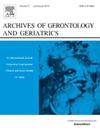Combined association of social isolation and loneliness with frailty onset among independent older adults: A JAGES cohort study
IF 3.5
3区 医学
Q2 GERIATRICS & GERONTOLOGY
引用次数: 0
Abstract
Objectives
Social isolation and loneliness each have negatively affect various health outcomes. No studies have examined the combined association of social isolation and loneliness on frailty onset. This study aimed to investigate both the objective and subjective aspects of isolation by evaluating social isolation and loneliness and to determine their interaction effects on frailty onset.
Methods
This cohort study used data from the 2019 and 2022 Japan Gerontological Evaluation Study. The eligible participants were independent older adults aged ≥65 years without frailty in 2019. The outcome variable was frailty onset in 2022. The exposure variables were social isolation and loneliness in 2019. Risk ratios (RR) and 95 % confidence intervals (CI) were estimated using modified Poisson regression models, with potential confounders as covariates. Moreover, a multiplicative scale and relative excess risk due to interaction (RERI) was used to assess the interaction.
Results
The analysis included 8440 participants (mean age: 73.2 [standard deviation, 5.5] years). During the follow-up, 15.1 % of participants experienced frailty onset. After adjusting for all covariates, the “severe isolation” & “severe loneliness” group had the highest risk of frailty onset (RR = 2.09 [95 % CI: 1.60–2.73]) compared to “no isolation” & “no loneliness” group. However, there were no significant multiplicative and additive interaction between social isolation and loneliness on frailty onset (multiplicative scale: 0.75 [95 % CI: 0.50–1.11]; RERI:0.29 [95 % CI:1.02–0.44]).
Discussion
These findings highlight the importance of considering social factors such as interaction with others and loneliness, to prevent frailty.
独立老年人中社会孤立和孤独与虚弱发作的联合关联:一项JAGES队列研究
目的社会孤立和孤独对各种健康结果都有负面影响。没有研究调查过社会孤立和孤独与虚弱发作的联合关系。本研究旨在通过评估社会孤立和孤独感,从客观和主观两个方面探讨孤立,并确定它们对虚弱发作的相互作用。方法本队列研究使用2019年和2022年日本老年学评估研究的数据。符合条件的参与者是2019年年龄≥65岁且无虚弱的独立老年人。结果变量为2022年发病虚弱。2019年的暴露变量是社会隔离和孤独。使用修正泊松回归模型估计风险比(RR)和95%置信区间(CI),并以潜在混杂因素作为协变量。此外,使用乘法量表和相互作用的相对超额风险(rei)来评估相互作用。结果共纳入8440例受试者,平均年龄73.2岁(标准差5.5岁)。在随访期间,15.1%的参与者经历了虚弱发作。在调整了所有协变量后,“严重隔离”&;与“无隔离”组相比,“严重孤独”组出现虚弱发作的风险最高(RR = 2.09 [95% CI: 1.60-2.73]);“不孤独”小组。然而,社会隔离和孤独感对虚弱发作没有显著的乘法和加法交互作用(乘法尺度:0.75 [95% CI: 0.50-1.11];瑞比:0.29 [95% ci: 1.02-0.44])。这些发现强调了考虑社会因素的重要性,如与他人的互动和孤独,以防止脆弱。
本文章由计算机程序翻译,如有差异,请以英文原文为准。
求助全文
约1分钟内获得全文
求助全文
来源期刊
CiteScore
7.30
自引率
5.00%
发文量
198
审稿时长
16 days
期刊介绍:
Archives of Gerontology and Geriatrics provides a medium for the publication of papers from the fields of experimental gerontology and clinical and social geriatrics. The principal aim of the journal is to facilitate the exchange of information between specialists in these three fields of gerontological research. Experimental papers dealing with the basic mechanisms of aging at molecular, cellular, tissue or organ levels will be published.
Clinical papers will be accepted if they provide sufficiently new information or are of fundamental importance for the knowledge of human aging. Purely descriptive clinical papers will be accepted only if the results permit further interpretation. Papers dealing with anti-aging pharmacological preparations in humans are welcome. Papers on the social aspects of geriatrics will be accepted if they are of general interest regarding the epidemiology of aging and the efficiency and working methods of the social organizations for the health care of the elderly.

 求助内容:
求助内容: 应助结果提醒方式:
应助结果提醒方式:


